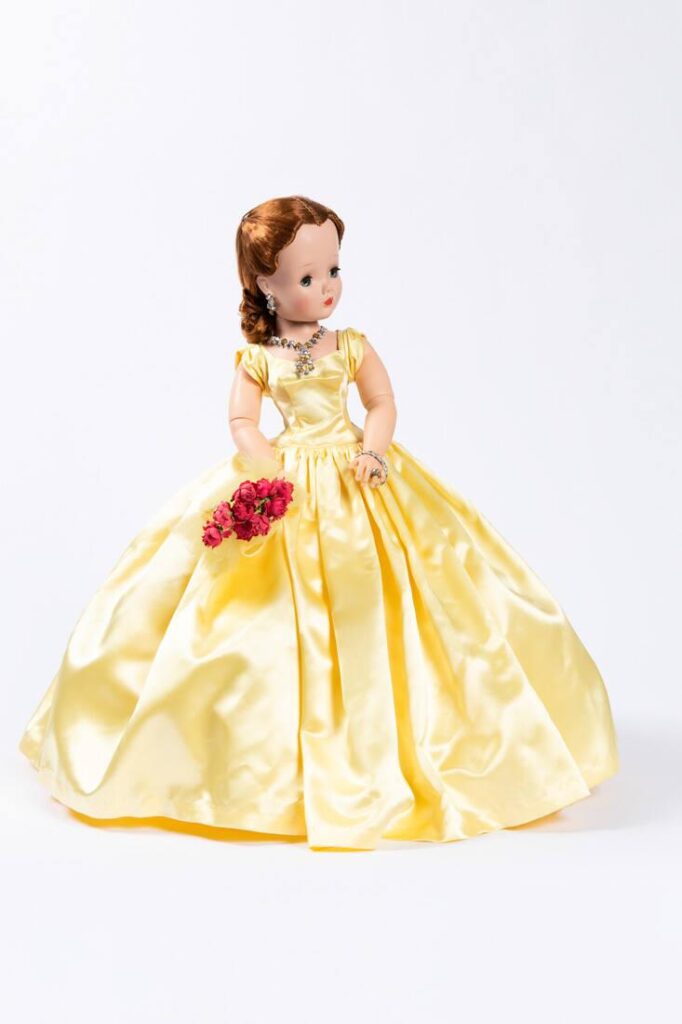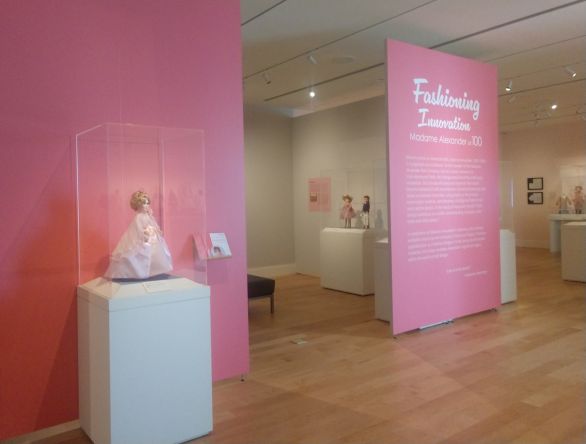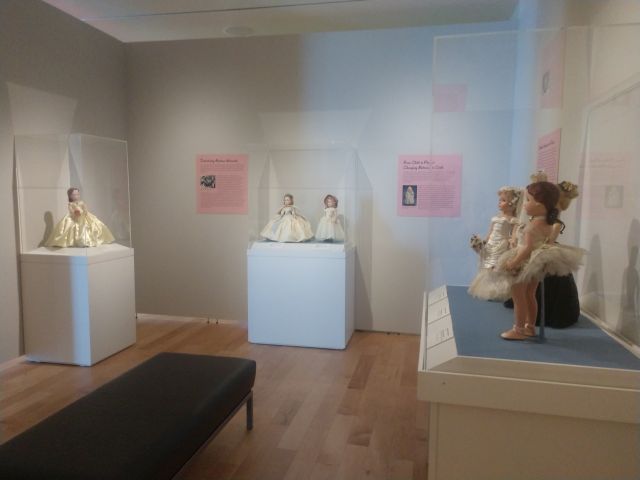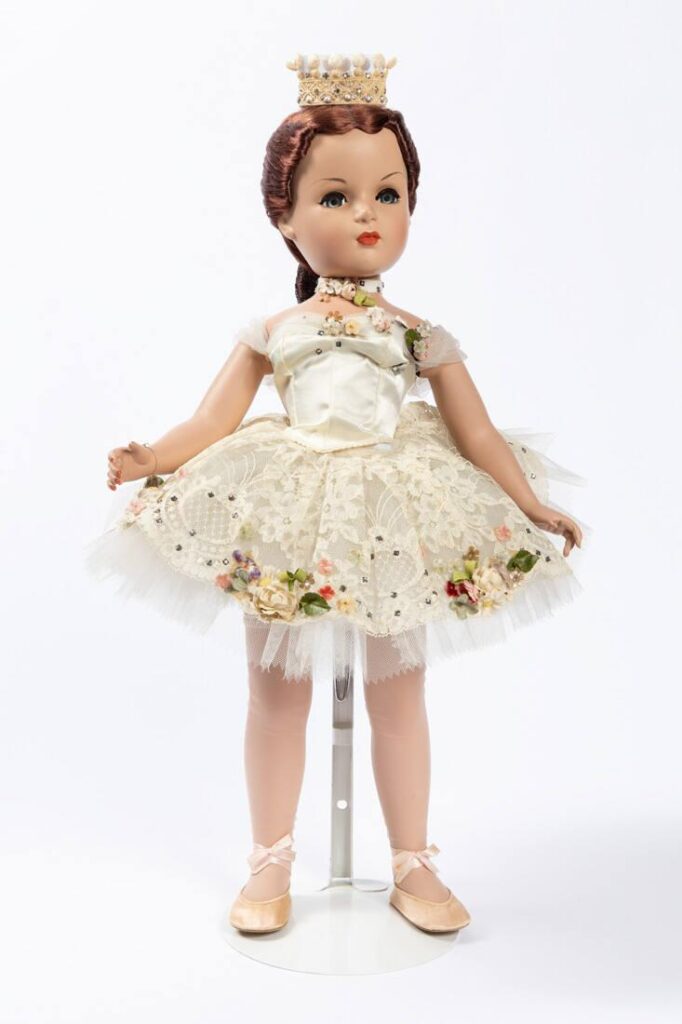It’s been a while since I’ve talked about the Barry Art Museum, but that doesn’t mean I haven’t been working on projects for them. Earlier this week, we opened a new doll exhibition, Fashioning Innovation: Madame Alexander at 100. Let’s check it out!
About Madame Alexander
Born in New York, Beatrice Alexander (1895-1990) was the daughter of Jewish immigrants who fled persecution in Europe and Russia. Originally named Bertha, she later changed it to Beatrice because she thought it sounded more elegant. Similarly, the name she gave her business– Madame Alexander Doll Company – aspired to evoke refinement and romance.
Alexander and her three sisters grew up in Manhattan’s Lower East Side, where her stepfather Maurice operated a doll hospital. Witnessing the despondency of young girls over their broken dolls deeply affected Alexander. She became determined to develop an unbreakable doll. In 1923, she opened her own business, though she began making dolls much earlier during World War I.

Initially, Alexander ran her business from home. After renowned New York toy company F.A.O. Schwarz began featuring Alexander’s dolls in its store, her company expanded significantly, occupying different office spaces. During the 1950s, she moved her business into a vacated Studebaker factory in Harlem. Eventually, she employed over 650 local workers. Throughout her career, the bond she had observed between children and their dolls dictated her design decisions. Her goal was to create dolls that could be playthings, educators, and friends to their young owners.
There’s actually a wonderful children’s book telling Alexander’s story. It’s written by Susan Goldman Rubin and illustrated by Sarah Dvojack. You can check it out here.
What’s distinctive about Madame Alexander Dolls?
When it comes to American dolls, Alexander is recognized as a trailblazer. She introduced ideas and materials that would become standard in doll manufacture. Some of these include developing dolls based on licensed characters, using plastic as her primary construction material (helping to make, for better or worse, the modern world a plastic one), and debuting a full-figured fashion doll years before Barbie.

That fashion doll, Cissy, is especially renowned among collectors. Four years before Mattel unveiled Barbie in 1959, Madame Alexander introduced Cissy. Intended to represent a modern adolescent debutante, she made her official debut in 1955. While critics decried her full-figured body as inappropriate for children, Cissy became popular among consumers and remained in production until 1962.
As with Alexander’s other dolls, Cissy was designed for both education and play. Alexander intended Cissy to model appropriate etiquette and fashions for young ladies. Her wardrobe featured modern clothing for a variety of social events, from casual daywear to elegant evening attire. Alexander intended Cissy as a role model for girls, a refined, affluent young woman who actively participated in a variety of social and cultural activities. While her representation of gender and social roles may appear restrictive to twenty-first-century viewers, in midcentury America Cissy’s embodiment of modern, youthful maturity proved innovative and influential. She set a precedent for future fashion dolls from Barbie to Bratz.
Curatorial Process
This was the last show I worked on for the Barry before taking a mandatory summer break. Normally, recipients of the Halleran dissertation fellowship aren’t allowed to hold outside employment. The dean and I worked out a compromise though, because we agreed that maintaining employment at a museum would be good for my resume. We decided that I would work with the Barry in the fall and spring semesters, but not the summer.
This means that I was most involved with the exhibit’s early stages, though I did as much as I could before I left for the summer. I conducted the research, wrote the texts, made a preliminary checklist, and selected the wall colors. Since I knew the checklist would be subject to change after I left for the summer, I kept the texts general. As with the bébé show, I focused on themes rather than specific objects.


The colors were especially fun to choose. I selected a light gray for the main gallery, as the Barry staff had expressed interest in a flexible color that could work for future installations. For the accent wall, I picked a light pink since that was Alexander’s favorite color. I also consulted with the graphic designers about the show’s aesthetic. Since the museum’s examples of Alexander dolls dated from the 1950s, we opted for a midcentury aesthetic.
But you can only anticipate so much. I planned as much as I could, but I couldn’t oversee the final details of the exhibition layout and object placement. Instead, the rest of the Barry Art Museum staff took care of that. In keeping with the museum’s embrace of teamwork, this is a collaborative exhibition. Everyone contributed to its content and appearance, and it’s all the better for it.
What’s in the show?
The exhibition is a mixture of the permanent collection and loans from a private collector. When I created the initial checklist, I wanted to showcase the variety of Alexander’s oeuvre and her various innovations. I included a few examples of Cissy dolls wearing different fashions, from full-length evening gowns to more casual overalls or pants. I also included examples of trademarked celebrities and figures. Knowing I couldn’t be available to fine-tune these selections, I kept the themes general in case better examples came up as the installation commenced.

The Alexader Doll Company, Ballet des Fleurs Portrait Doll, ca. 1951, Collection of the Barry Art Museum. Alexander drew inspiration from art and literature for her dolls, in this instance the paintings of Degas.
Part of the fun of attending the exhibition opening was seeing how the show finally turned out. I did see a few installation shots ahead of time, but that’s different from experiencing the show in person. While my basic concepts more or less remained the same, some of the dolls were different from my original selections. Ultimately though, I liked the changes, and it was fun to see the variety of dolls on view.
My Thoughts on Madame Alexander
Like every other doll exhibition I’ve worked on, I’ve come to appreciate Madame Alexander and her dolls. I’ve been getting interested in the connections between dolls and women entrepreneurs since I first started working with the Barry’s doll collection a couple of years ago. When it comes to women and business, Alexander’s story is a fascinating one. As a Jewish woman in the male-dominated field of doll production and entrepreneurship, she had to overcome many social and financial challenges, from banks requiring men to approve loans to intense critique and scrutiny from competitors.
To weather these setbacks, Alexander maintained an independent, assertive demeanor, but her company embodied intimate, familial qualities. Her sisters helped produce her first dolls, and her children grew up in the business. Alexander’s husband, Phillip Behrman, managed the company’s finances so that she could focus on the creative side (Initially a bookkeeper for a local hat company, Behrman hesitated to work for Alexander full-time until she threatened him with divorce!). In addition to creating dolls that served as role models, Alexander also sought to empower women through her employment practices, often hiring local women to work in her factory.
Madame Alexander at 100 will be on view through December 31, so if you’re in town, be sure to check it out!
P.S. If you want to learn more about Madame Alexander and her dolls, check out this blog.